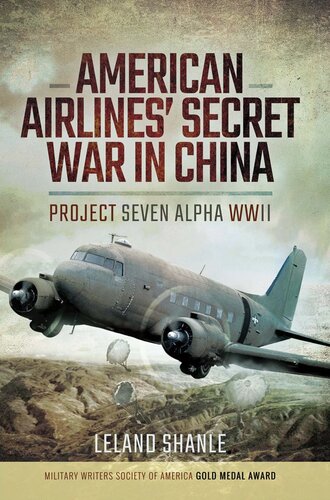oleebook.com
American Airline's Secret War in China: Project Seven Alpha, WWII de Leland Shanle
de Leland Shanle - Género: English
Sinopsis
In late 1941, President Roosevelt agonized over the rapid advances of the Japanese forces in Asia; they seemed unstoppable. He foresaw their intentions of taking India and linking up with the two other Axis Powers, Germany and Italy, in an attempt to conquer the Eastern Hemisphere. US naval forces had been surprised and diminished in Pearl Harbor and the army was not only outnumbered but also ill-prepared to take on the invading hoards. One of Roosevelts few options was to form a defensive line on the eastern side of the Patkai and Himalayan Ranges; there, he could look for support from the Chinese and Burmese. It was the only defense to a Japanese invasion of India.
To support and supply the troops who were fighting in hostile jungle terrain, where overland routes had been cut off, he desperately needed to set up an air supply from Eastern India. His problem was lack of aircraft and experienced pilots to fly the dangerous Hump, over the worlds highest mountains. Hence the inception of Operation Seven Alpha, a plan to enlist the aircraft-DC-3s-and the pilots-veterans of World War One-of American Airlines. This newly formed elite Squadron would fly the medium-range aircraft in a series of long-distance hops across the Pacific and Southern Asia to the Assam Valley in India. They would then create and operate the vital supply route, carrying arms, ammunition and food Eastward to the Allied bases, before returning with wounded personnel. This is the story of that little-known operation, carried out in the early days of the Burma Campaign.
The book is based on first-hand experiences of those who were involved, and it serves as a fitting tribute to the bravery and inventiveness of a band of men who answered their countrys desperate call at the outset of the war against Japan in Asia.
Libros Recomendados - Relacionados
Reseñas Varias sobre este libro
Project Seven Alpha, by Leland Shanle
While this book has been described as historical fiction, it would be better described as historical fantasy.
The promotional material available on this 2008 publication touts it as the story of this little-known operation in the early days of the Burma Campaign. The reason is that it is little known is that it never happened!
Ostensibly it is the recounting of how the day after Pearl Harbor, the head of American Airlines (the legendary C.R. Smith, who was a real person who became a key organizer of the Air Transport Command) is summoned to the White House and asked to send civilian airliners from the AA fleet on a dash across the Pacific to provide support for cargo operations in Burma.
Immediately swinging into action, Smith gathered 8 crews, a mix of former WWI fighter pilots and an assortment of untested copilots, and dispatches them across country. One of the pilots brings along his 17 year old son to sit in the second seat. Some how they are all immediately commissioned, complete with spiffy new flight jackets. Leaving the West Coast, they fly to still smoldering Hawaii with the fires of Pearl Harbor guiding them in. (One of the first red flags for accuracty is they are greeted by shark mouthed P-40s . shark mouth markings were not in use in Hawaii at the time).
Inexplicably, they are then routed to Wake Island, which is under imminent attack from a Japanese task force. Of course they manage to take off just minutes before the Japanese strike. The same happens at their next stop in the Philippines. And then they have to avoid hostile forces to make it across Malaysia.
Lets just stop here a minute. The ultimate destination for this mission is supposed to be Calcutta, India. You dont have to be much of a student of history to ask why werent these highly valuable aircraft and crews routed through South America, across the ocean to Africa, crossing the narrow point of the ocean to Africa, and then over through to India and Burma. With the war raging since the mid 1930s, such safer routes were already well recognized. But of course this would have made for a much less exciting tale than one of death waiting over every horizon.
There are also other pain points in reading this story. The characters are all stereotypes, recognizable to anyone who reads flight literature. The older pilots are have nerves of steel, push their aircraft beyond rated limits, and apparently never make a mistake no matter how extreme the operating conditions. The younger copilots, who seem to all have the uniformly same lack of experience, are all in awe. Staff officers at various airfields are all stuffed shirts telling the real pilots how to do their job while attempting to burden them down with bureaucratic details.
There are even stereotypes of ground troops, including an old school British colonel who goes down with the ship in Malaysia, a younger major who is dispatched away from the Japanese onslaught with a select group of officers and NCOs to form a line of resistance with a reformed army in Burma, a rock hard Sergeant Major who had both the respect and fear of his men, and a contingent of US Marines who had somehow survived the evacuation of the embassy in Peking and were now eagerly joining the fight. All of these are rendered in movie character shorthand to keep the story moving along.
The worst aspect of this book is that it steals the title of an actual Project 7-A that came much later in the war. Under this codename American Airline pilots were contracted in 1943 to fly C-87s (cargo version of the B-24) over the hazards of the Himalayas. This is the real story that should have been told under this title.
If this book has any redeeming values, it is the authors excruciating attention to detail on how cargo aircraft were flown in the 1940s. If that is your interest, then this book is for you. The only thing missing is a full and complete take off and landing checklist, but the exhaustive narrative comes very close, along with the details of cross country navigation and communications techniques. Other reviewers have noted that the technical details of the story get very much in the way of the personal story of the characters.
The author is a pilot, with both military and civilian experience, and it shows. However another reviewer noted that he had a tendency to inject modern terms into conversations taking place in 1941. For my view, I thought it was questionable to claim that pilots inexperienced in formation flying with minimal training would be landing cargo aircraft on a rough field within a 3 second interval apparently in order to avoid detection.
My final criticism of this book is that based on the number of four and five star ratings appearing on the internet, it appears a number of readers have interpreted this book to be historical fact rather than fiction. None of the web references that I could find this book have highlighted how historically inaccurate this book is, or have pointed the reader the real story of American Airline pilots operating in wartime. According to other notes, a movie script has been prepared to perpetuate this tale of fantasy. The author and the publisher could have made a better effort to let the reader know exactly what this story is the product of a fanciful imagination.
aviation fiction japan ...more2 s MarkAuthor 4 books12
Wonder what it was to 'Fly the Hump' in WWII? After reading 'Project Seven Alpha' you'll feel you been through the war, from the cockpit, and you'll have engine oil on your shirt, sweat under your armpits, and you'll be loving every minute of it. This is one of the best historical fiction novels I've read.
2 s Douglas E4
Mostly Interesting
Good read but was turned off by the usage of the phonetic alphabet that didnt exist in the timeframe in which the book was written. The implementation of the Alfa, bravo, Charlie, delta, etc. occurred in the mid fifties. Even the books title should be: Project Seven Able.
Ralph l. Quackenbush3
Autor del comentario:
=================================












